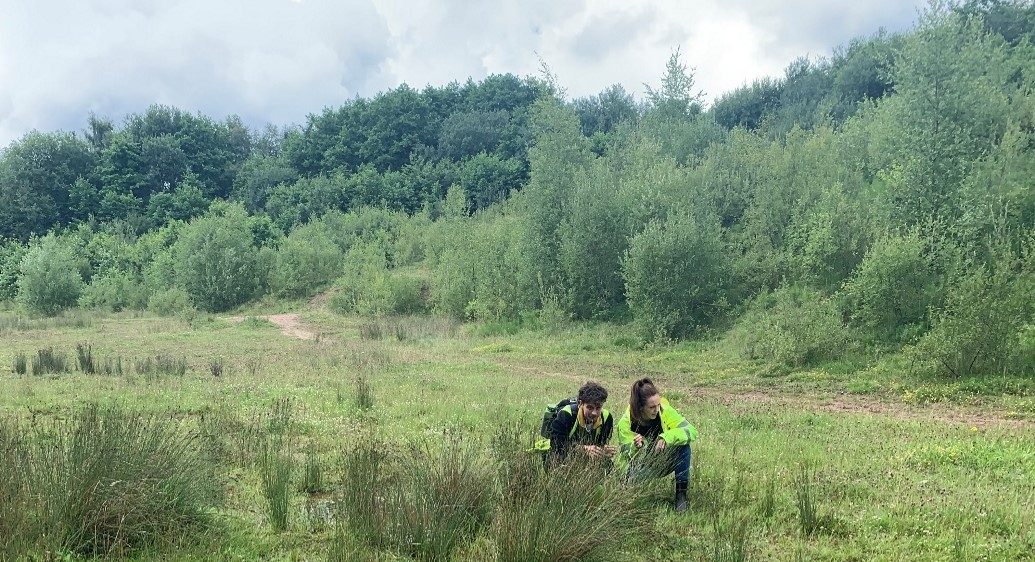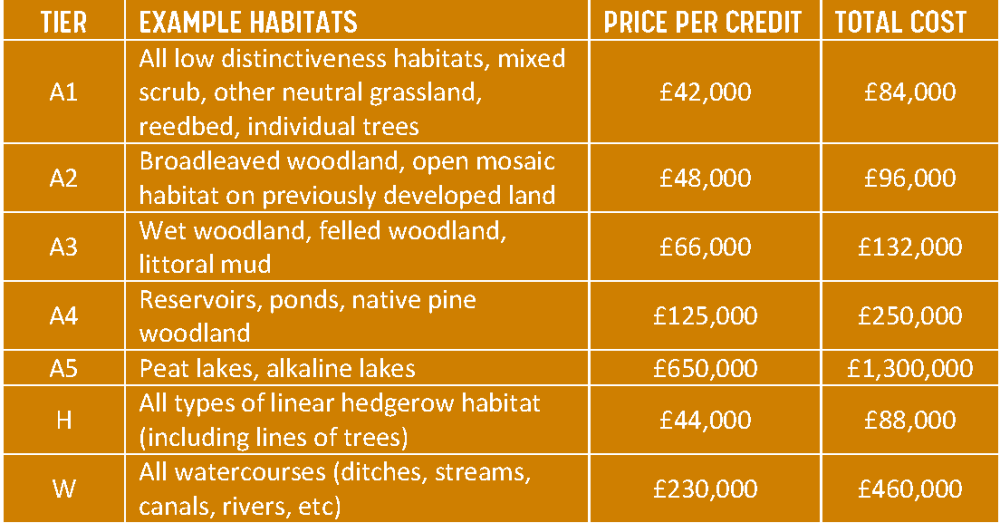- 12 Feb 2024
Biodiversity Net Gain (BNG) is now mandatory for all new planning applications.

As of Monday 12th February, Biodiversity Net Gain (BNG) is mandatory for all new planning application, under Schedule 7A of the Town and Country Planning Act 1990 (as inserted by Schedule 14 of the Environment Act 2021).
Developers must deliver at least a 10% net gain in biodiversity as a legal condition of the development, unless exempt, however individual LPAs may request a higher net gain target.
The 10% target applies to area habitats, linear hedgerow habitats and watercourse habitats individually. Not all sites will have all three habitat categories and if a certain category is not present then an uplift in this category is not required. There can be no trading or averaging of units between different categories.
Which developments are exempt from mandatory BNG?
- Small sites
- Residential developments – Between 1-9 dwellings proposed, or <0.5ha in total
- Commercial developments – <1000m2 of commercial floorspace created, or <1ha total size
- Will become mandatory 2nd April 2024
- Developments that impact:
- <25m2 of non-priority habitat
- <5m of linear non-priority habitats
- House holder projects (e.g., home extensions, conservatories, etc)
- Self-build and custom build applications
- Off-site mitigation sites being used to offset another development (not held to separate 10% target)
- High speed rail transport
- Nationally Significant Infrastructure Projects
- Will become mandatory November 2025
Statutory BNG is now managed and owned by the Department for Environment, Food and Rural Affairs.
What are the responsibilities of DEFRA?
- Laying regulations (alongside Department of Levelling Up, Homes and Community)
- Produce and own the statutory instruments for BNG:
- User guidance
- Statutory Metric
- Condition assessment sheets
- Running consultations for:
- Metric updates (every 3-5 years)
- Irreplaceable habitats (later this year)
- Credit updates (every 6 months)
What is the role of Natural England?
- No longer statutory consultee for BNG (this is responsibility of LPAs)
- Run National Net Gain Register for offsite mitigation sites
- Operate the statutory credits system and sales
- Macro-level monitoring of the implementation of BNG
- Produce guidance (advisory not legislative)
- Produced monitoring plan template (though not mandatory)
BNG feeds into all steps of planning, and should be considered throughout the planning process.
The Steps of Mandatory BNG
Pre-App advice
- Consider BNG early in the process
- Check the % requirement for LPA (can be >10%)
- Request any documents necessary for assessing strategic significance
- Provide as much information relating to BNG as early as possible
- We recommend completing a BNG Feasibility Assessment for this step to determine the baseline of the site
Planning Application
- Documents relating to Biodiversity Net Gain will be required for validation
- Legal minimum requirement is a Biodiversity Statement, which sets out whether a site is or is not exempt from BNG
- If exempt, evidence is required
- LPA will likely ask for more information, particularly if there will be significant onsite enhancements
- If offsite mitigation is required, land will need to be secured through a legal agreement (particularly for an S106) prior to planning being granted
- For an outline planning application we recommend completing a BNG Feasibility Assessment
- For a full planning application we recommend completing a BNG Design Stage Assessment
Pre-Commencement
- Once planning permission is granted, a Biodiversity Gain Plan must be provided prior to commencement of works
- This includes:
- Completed biodiversity gain plan form (https://www.gov.uk/government/publications/biodiversity-gain-plan)
- For offsite mitigation, the Biodiversity Net Gain Register reference number or proof of purchase for Statutory Credits are required
- A Habitat Management and Monitoring Plan (can use template, though not mandatory)
- Compensation plan (if irreplaceable habitats impacted – they can be enhanced but not degraded within BNG)
- If offsite/statutory credits are needed, the land proposed to be used will need to be registered on the Natural England register
When designing a scheme, the biodiversity gain hierarchy should be considered, to ensure the best outcome for biodiversity.
What is the Biodiversity Gain Hierarchy?
- It differs slightly from the mitigation hierarchy as it is more specific to BNG
- Medium, high and very high distinctiveness habitats should be avoided
- If loss can’t be avoided, they must be appropriately mitigated for
- Any habitats impacted by development should be mitigated through:
- Retention and enhancement of any parcels remaining
- Creation onsite
- Offsite mitigation
- Statutory Credits (last resort, evidence for their use is required)
- Applicants must either demonstrate how the hierarchy is being followed, or justify why if it is not being followed
If the 10% BNG target cannot be achieved onsite, then offsite mitigation will be necessary to achieve this target. Landowners must register any land that will be used for offsite mitigation on the Natural England Offsite Register.
What is the offsite register?
- This will go live on the 12th February, alongside mandatory BNG
- It is operated by Natural England
- Their role will be to check all legal requirements and necessary information has been provided
- Financial checks will be completed which may incur fees
- Natural England will not vet the correctness of the BNG assessments
- This is not a marketplace for offsite units, though these are appearing (for example, The Environmental Trading Platform)
- Land can be registered prior to being used for mitigation
What are Statutory Credits?
- A last resort, national credit system for when there are no other offsite options available. Proof that you’ve exhausted other options will be required to purchase credits
- Credit prices are tiered, based on habitat type
- Prices do not include VAT
- A spatial risk multiplier is applied to all prices, which means that two statutory credits are required for every one biodiversity unit that needs compensating for

- Natural England will manage the sale process, and the money will be invested in habitat creation and enhancement projects across England
What happens if a development produces a net gain >10%?
- Excess units produced can be used to count towards the BNG of another development
- These units would be treated as off-site gain, and will require:
- A legal agreement to be secured
- Registration in the biodiversity gain sites register
- Allocation to the other development and inclusion in the metric as off-site mitigation
- Inclusion in the biodiversity gain plan for the other development
As part of mandatory BNG, all significant onsite enhancements and off-site gains must be legally secured for 30 years through a planning condition, planning obligation or conservation covenant.
What are onsite significant enhancements?
- Areas of habitat enhancement that contribute significantly to the post-development BNG value of a site relative to the baseline, such as:
- Habitats of medium distinctiveness or higher
- Habitats of low distinctiveness that contribute a large number of biodiversity units
- Habitat creation or enhancement where the distinctiveness is increased
- Areas of habitat creation or enhancement which contribute a significant area relative to the overall size of the site
- Enhancement to the condition of a habitat
- Retention of existing habitats does not count as an on-site enhancement and does not need to be secured
- Non-significant enhancements will still be included within the BNG calculation but do not need to be legally secured or managed (e.g., vegetated private gardens)
How will BNG be monitored and enforced?
- All significant onsite and offsite enhancements must be legally secured for 30 years
- LPAs are responsible for enforcing planning conditions and planning obligations (following the Town and Country Planning Act)
- They must also report on actions taken every 5 years
- Responsible bodies are responsible for enforcing conservation covenants (outlined in Environment Act)
- Natural England have produced a Habitat Monitoring and Management Plan template, though other formats can be used
All guidance is available on the Gov.uk website https://www.gov.uk/government/collections/biodiversity-net-gain